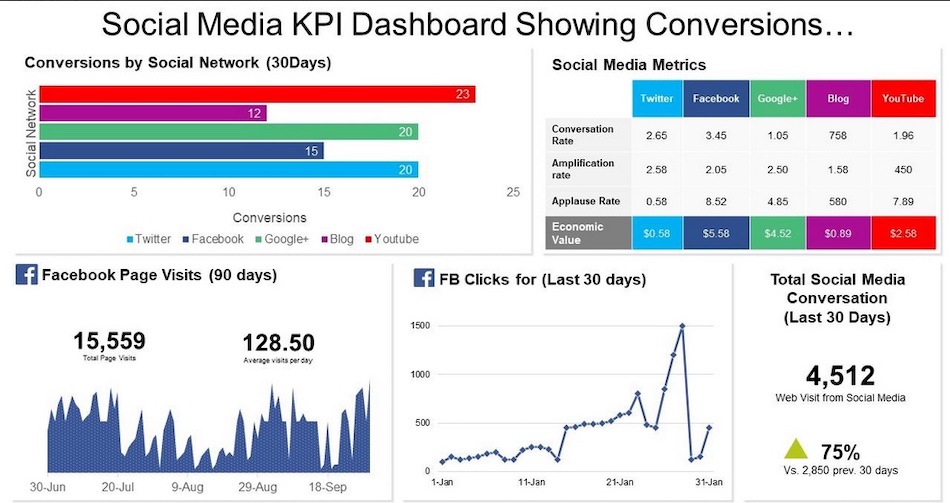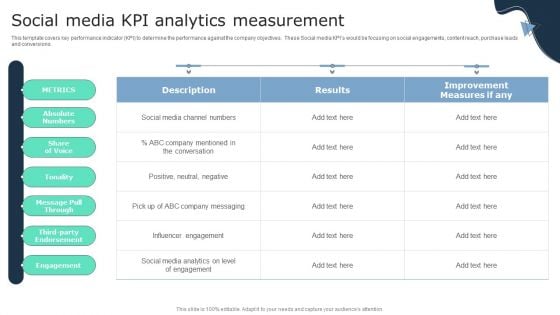Discover the ultimate guide to tracking social media KPIs, including tools and tips to boost engagement and ROI!

Image courtesy of via DALL-E 3
Table of Contents
Introduction to Social Media KPIs
Social media has become an essential part of our daily lives. We use platforms like Facebook, Instagram, and Twitter to connect with friends, share experiences, and even discover new products. But have you ever wondered how companies measure their success on social media? This is where Social Media Key Performance Indicators (KPIs) come into play.
What are KPIs?
KPIs stand for Key Performance Indicators. These are specific metrics that help businesses understand how well their social media strategies are performing. Imagine KPIs as your report card for social media – they show you what’s working well and what needs improvement. Examples of KPIs include the number of likes, comments, shares, and followers a post receives.
Importance of KPIs in Social Media
Tracking KPIs is crucial because it allows companies to see the impact of their social media efforts. By analyzing these metrics, businesses can make informed decisions on what content resonates with their audience and how to improve engagement. In simple terms, KPIs help businesses understand if their social media strategies are successful or not.
Common Social Media KPIs
When it comes to social media, Key Performance Indicators (KPIs) play a crucial role in understanding how well your strategies are working. Let’s delve into some of the most common KPIs used in social media and what they measure.
Engagement
Engagement is all about how much your audience interacts with your content. It’s measured by the number of likes, comments, and shares your posts receive. The higher the engagement, the more connected your audience is with your brand.
Reach
Reach shows the number of people who see your social media posts. It indicates the potential size of your audience. The higher the reach, the more exposure your content is getting.
Impressions
Impressions refer to the total number of times your posts have been viewed. Unlike reach, impressions count every time your content is displayed. It gives you an idea of how many times your posts have been seen, even if by the same person multiple times.
Followers
The number of followers you have on social media is a key KPI that shows the growth of your audience. A growing follower count indicates an expanding reach and potential for engagement. It’s important to track this metric to gauge the effectiveness of your content and strategies in attracting and retaining followers.
Tools for Tracking Social Media KPIs
Tracking social media Key Performance Indicators (KPIs) is essential for understanding the effectiveness of your online strategies. To make this task easier, there are various tools and software available that can help you monitor and analyze your social media performance. Let’s take a look at some of the most popular options:

Image courtesy of via Google Images
Google Analytics
Google Analytics is a powerful tool that allows you to track various metrics related to your website and social media channels. With Google Analytics, you can see how many visitors come to your site from different social media platforms, how long they stay on your site, and which pages they visit most frequently. This tool provides valuable insights into the impact of your social media efforts.
Hootsuite
Hootsuite is a social media management platform that offers a wide range of features for monitoring and analyzing KPIs. With Hootsuite, you can schedule posts, engage with your audience, and track the performance of your social media campaigns. The platform also provides detailed analytics to help you understand how your content is performing and make data-driven decisions.
Buffer
Buffer is another popular tool for planning and analyzing social media activities. With Buffer, you can schedule posts across multiple social media platforms, track engagement metrics such as likes and comments, and measure the effectiveness of your campaigns. The platform also offers in-depth analytics to help you optimize your social media strategy.
Sprout Social
Sprout Social is a comprehensive social media management tool that allows you to monitor, engage, and analyze your social media performance. With Sprout Social, you can track KPIs such as reach, engagement, and follower growth, and generate customizable reports to share with your team. The platform also offers social listening capabilities to help you understand what your audience is saying about your brand.
Tips for Effective Tracking
When it comes to tracking and analyzing social media Key Performance Indicators (KPIs), there are some important tips to keep in mind to ensure you are getting the most out of your data. Here are some practical tips for effectively tracking and analyzing social media KPIs:
Set Clear Goals
Before you start tracking any KPIs, it is crucial to have clear and measurable goals in mind. Identify what you want to achieve with your social media efforts, whether it’s increasing brand awareness, driving website traffic, or generating leads. Having well-defined goals will help you track the right metrics and assess the success of your strategies.
Regular Monitoring
Consistent monitoring of your social media KPIs is essential to stay updated on your performance trends. Set aside dedicated time to regularly check your metrics and analyze the data. By monitoring your KPIs frequently, you can identify any changes or patterns early on and make timely adjustments to your strategies.
Adjust Strategies
Don’t be afraid to make changes to your social media strategies based on the insights you gather from tracking your KPIs. If you notice certain tactics are not performing as expected or if you see an opportunity for improvement, be willing to adjust your approach. Use the data from your KPIs to inform your decision-making and optimize your social media efforts for better outcomes.
Understanding KPI Data
When you track Key Performance Indicators, or KPIs, on social media, you gather a lot of data. This data is like pieces of a puzzle that can help you understand how well your social media efforts are working. Let’s dive into how to make sense of this data!

Image courtesy of via Google Images
Analyzing Trends
One way to understand KPI data is by analyzing trends. Trends are like the weather – they show you if things are getting better or worse over time. For example, if you see that the number of likes on your posts is going up every month, that’s a positive trend! On the other hand, if the number of shares is decreasing, that’s a negative trend. By spotting these trends, you can make informed decisions on how to improve your social media strategy.
Comparative Analysis
Comparative analysis is another helpful way to understand KPI data. This means looking at how your current data compares to data from the past. For instance, you can compare this month’s reach with last month’s reach to see if you’re reaching more people now. If you notice a significant drop in engagement compared to last year, it might be time to reevaluate your content strategy. Comparing data over time gives you insight into what’s working well and what needs adjustments.
Common Mistakes to Avoid
One common mistake many people make when tracking social media KPIs is ignoring the data they collect. It’s crucial to pay attention to the insights provided by the data and use them to make informed decisions. By ignoring the data, you could miss out on valuable opportunities to improve your social media strategies and engagement.
Over-Reliance on a Single KPI
Another mistake to avoid is over-relying on a single KPI when analyzing social media performance. While focusing on one key metric can be helpful, it’s essential to consider a variety of KPIs to get a comprehensive view of your social media success. Relying too heavily on one KPI can be misleading and may not provide a complete picture of your overall performance.
Not Setting Goals
Tracking social media KPIs without having clear goals in mind is a common pitfall. Setting specific, measurable goals is essential for accurately assessing the effectiveness of your social media strategies. Without clear goals, you may not know what you are aiming to achieve or how to measure the success of your efforts. Make sure to define your objectives before tracking KPIs to ensure meaningful insights.
Benefits of Tracking Social Media KPIs
In the world of social media, tracking Key Performance Indicators (KPIs) can offer a multitude of benefits for businesses and individuals alike. By keeping a close eye on these metrics, you can gain valuable insights into how well your social media strategies are performing and make informed decisions to drive success. Let’s dive into the advantages of tracking social media KPIs:

Image courtesy of via Google Images
Improved Performance
Tracking social media KPIs allows you to measure the effectiveness of your efforts and identify what is working well and what needs improvement. By analyzing these metrics, you can fine-tune your strategies, optimize your content, and enhance your overall performance on social media platforms. This data-driven approach helps you make informed decisions that can lead to better results and a stronger online presence.
Greater Audience Engagement
Understanding your social media KPIs can provide valuable insights into how your audience is interacting with your content. By tracking measures like engagement rate, reach, and impressions, you can gauge the level of interest and interaction your posts are generating. With this information, you can create more engaging and relevant content that resonates with your audience, ultimately leading to increased engagement, likes, shares, and comments. By fostering a deeper connection with your followers, you can cultivate a loyal community that actively engages with your brand.
Conclusion and Summary
Throughout this blog post, we delved into the world of social media Key Performance Indicators (KPIs) to understand their significance in evaluating the success of social media strategies. KPIs serve as vital metrics that help individuals and businesses gauge their performance and make informed decisions to enhance their online presence.
Key Takeaways:
We began by defining KPIs as Key Performance Indicators that provide valuable insights into the effectiveness of social media efforts. Examples of common KPIs such as Engagement, Reach, Impressions, and Followers were explored to grasp their meanings and significance.
Tools such as Google Analytics, Hootsuite, Buffer, and Sprout Social were introduced to facilitate the tracking and analysis of social media KPIs, empowering users to monitor their performance efficiently and effectively.
We also shared practical tips for effective KPI tracking, including setting clear goals, regular monitoring, and adjusting strategies based on the data collected. By understanding and interpreting KPI data, individuals can make informed decisions to optimize their social media performance.
Moreover, we highlighted the benefits of tracking social media KPIs, such as improved performance and increased audience engagement, underscoring the positive impact of leveraging KPI data for growth and success.
In conclusion, tracking social media KPIs is not just a practice but a strategic necessity for anyone looking to thrive in the digital landscape. By analyzing KPIs, setting objectives, and adapting strategies accordingly, individuals and businesses can unlock the full potential of their social media presence and achieve meaningful results.
Want to turn these SEO insights into real results? Seorocket is an all-in-one AI SEO solution that uses the power of AI to analyze your competition and craft high-ranking content.
Seorocket offers a suite of powerful tools, including a Keyword Researcher to find the most profitable keywords, an AI Writer to generate unique and Google-friendly content, and an Automatic Publisher to schedule and publish your content directly to your website. Plus, you’ll get real-time performance tracking so you can see exactly what’s working and make adjustments as needed.
Stop just reading about SEO – take action with Seorocket and skyrocket your search rankings today. Sign up for a free trial and see the difference Seorocket can make for your website!
FAQs
Why are KPIs important?
KPIs, or Key Performance Indicators, are important because they help us understand how well our social media strategies are working. They give us valuable insights into the performance of our posts, the engagement of our audience, and the growth of our followers. By tracking KPIs, we can see what is working well and what needs improvement, allowing us to make informed decisions to enhance our social media presence.
Which tool is best for tracking KPIs?
The best tool for tracking KPIs depends on your specific needs and goals. There are various tools available, such as Google Analytics, Hootsuite, Buffer, and Sprout Social, each offering unique features for monitoring and analyzing social media KPIs. It is essential to choose a tool that aligns with your objectives and provides the data and insights you require to track your KPIs effectively.
How often should I track KPIs?
Tracking KPIs regularly is crucial to stay informed about the performance of your social media activities. Depending on your goals and the nature of your content, you may choose to track KPIs daily, weekly, or monthly. By monitoring KPIs at regular intervals, you can identify trends, make timely adjustments to your strategies, and ensure that you are on track to achieve your social media objectives.







